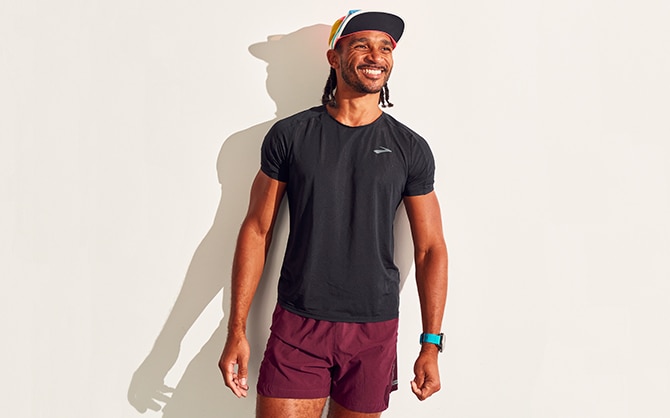Core Workouts for Runners

Pro running coach and yoga instructor Tywon Thompson shares six core exercises for runners.
Why is core strength important for runners?
When we talk about our core, we are referring to the group of muscles in the middle section of the body — your abdominals, obliques, diaphragm, pelvic floor, trunk extensors, and hip flexors. Think of how a tree’s trunk keeps it from toppling over. Our body’s core works in a similar way. Exercising these muscles regularly can help runners with flexibility, balance, and endurance.
Tywon Thompson, who co-leads November Project Dallas, offers up a range of six core exercises for runners.
You can do these ab exercises in three to four rounds of 20 to 30 seconds per exercise. Tywon recommends doing core workouts at least three times a week.
Mountain climbers
- From a pushup position, bring your right knee toward your left tricep.
- Jump and switch legs to bring your left knee forward and your right foot back.
- Repeat and perform this exercise quickly, but with control.
Flutter kicks
- Lie down flat on your back with your legs stretched straight out to begin.
- Lift your legs up and down alternating left and right.
- Make sure to keep the core engaged by lifting the head.
Tip: If lifting your head is too much of a challenge, keep it down but be sure your back stays flat against the ground or mat.
Russian twists
- Sit on the ground with your knees bent at a 45-degree angle and keep your spine elongated.
- Keep your heels on the ground or lifted with your toes flexed.
- Try keeping your legs together as your body twists from side to side. If your heels are lifted, try keeping your legs stable as you twist from side to side.
Tip: If you want a challenge, pick up a weight, such as medicine ball, dumbbell, or even a cinder block, and hold that weight with both hands while twisting from side to side.
Clamshells
- Lie down on your side with legs and hips stacked and your knees bent at a 45-degree angle.
- Use one hand to support your head and the other to support your hips. Your top hand will help keep your hips centered and from moving backwards.
- Engage your abdominals by pulling in your lower belly. This will help keep the spine and pelvis stabilized.
- Keep your feet stacked and touching and try to lift your upper leg as high as you can without shifting your hips or your pelvis. Continue to press your lower leg against the floor and try not to move it.
Tip: Adding a resistance band around both legs just above the knees will help work your glutes and hamstrings, which will help support your core and back.
Level up: Scissor kicks
This exercise takes flutter kicks up a notch. Once you feel comfortable doing the beginner exercises in this core strength workout, feel free to add this to the routine.
- Lie down on your back with your legs straight.
- Begin crossing your legs back and forth as you are simultaneously lifting them.
- Keep your toes pointed or flexed toward you.
- Once at the top begin lowering the legs performing the same motion. Keeping your back flat allows you to engage the core while your head and / or shoulders are lifted off the ground.
Level up: High to low plank jacks
Ready for something more advanced? According to Tywon, this fun, challenging exercise engages nearly every muscle group in your core.
- Start in a high plank with wrists in line with shoulders and your legs straight and parallel.
- While in this position, begin separating the legs from one another by hopping them out to the sides and then back in together.
- When you are comfortable, continue this motion while also moving high plank to low plank — do this by bringing down one elbow at a time and returning to the high plank.
More training tips and core workouts
Feel like you have your core covered? Head to our Run Happy Blog to explore other running workouts, training tips, gear stories, and much more.